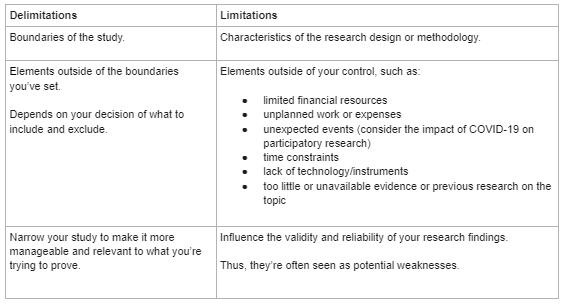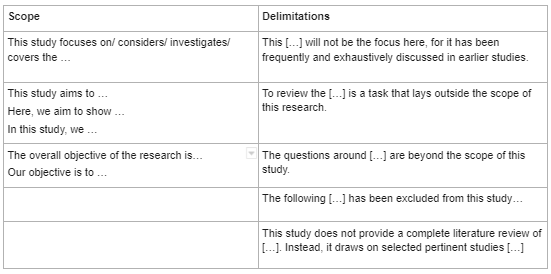- Privacy Policy

Home » Delimitations in Research – Types, Examples and Writing Guide

Delimitations in Research – Types, Examples and Writing Guide
Table of Contents

Delimitations
Definition:
Delimitations refer to the specific boundaries or limitations that are set in a research study in order to narrow its scope and focus. Delimitations may be related to a variety of factors, including the population being studied, the geographical location, the time period, the research design , and the methods or tools being used to collect data .
The Importance of Delimitations in Research Studies
Here are some reasons why delimitations are important in research studies:
- Provide focus : Delimitations help researchers focus on a specific area of interest and avoid getting sidetracked by tangential topics. By setting clear boundaries, researchers can concentrate their efforts on the most relevant and significant aspects of the research question.
- Increase validity : Delimitations ensure that the research is more valid by defining the boundaries of the study. When researchers establish clear criteria for inclusion and exclusion, they can better control for extraneous variables that might otherwise confound the results.
- Improve generalizability : Delimitations help researchers determine the extent to which their findings can be generalized to other populations or contexts. By specifying the sample size, geographic region, time frame, or other relevant factors, researchers can provide more accurate estimates of the generalizability of their results.
- Enhance feasibility : Delimitations help researchers identify the resources and time required to complete the study. By setting realistic parameters, researchers can ensure that the study is feasible and can be completed within the available time and resources.
- Clarify scope: Delimitations help readers understand the scope of the research project. By explicitly stating what is included and excluded, researchers can avoid confusion and ensure that readers understand the boundaries of the study.
Types of Delimitations in Research
Here are some types of delimitations in research and their significance:
Time Delimitations
This type of delimitation refers to the time frame in which the research will be conducted. Time delimitations are important because they help to narrow down the scope of the study and ensure that the research is feasible within the given time constraints.
Geographical Delimitations
Geographical delimitations refer to the geographic boundaries within which the research will be conducted. These delimitations are significant because they help to ensure that the research is relevant to the intended population or location.
Population Delimitations
Population delimitations refer to the specific group of people that the research will focus on. These delimitations are important because they help to ensure that the research is targeted to a specific group, which can improve the accuracy of the results.
Data Delimitations
Data delimitations refer to the specific types of data that will be used in the research. These delimitations are important because they help to ensure that the data is relevant to the research question and that the research is conducted using reliable and valid data sources.
Scope Delimitations
Scope delimitations refer to the specific aspects or dimensions of the research that will be examined. These delimitations are important because they help to ensure that the research is focused and that the findings are relevant to the research question.
How to Write Delimitations
In order to write delimitations in research, you can follow these steps:
- Identify the scope of your study : Determine the extent of your research by defining its boundaries. This will help you to identify the areas that are within the scope of your research and those that are outside of it.
- Determine the time frame : Decide on the time period that your research will cover. This could be a specific period, such as a year, or it could be a general time frame, such as the last decade.
- I dentify the population : Determine the group of people or objects that your study will focus on. This could be a specific age group, gender, profession, or geographic location.
- Establish the sample size : Determine the number of participants that your study will involve. This will help you to establish the number of people you need to recruit for your study.
- Determine the variables: Identify the variables that will be measured in your study. This could include demographic information, attitudes, behaviors, or other factors.
- Explain the limitations : Clearly state the limitations of your study. This could include limitations related to time, resources, sample size, or other factors that may impact the validity of your research.
- Justify the limitations : Explain why these limitations are necessary for your research. This will help readers understand why certain factors were excluded from the study.
When to Write Delimitations in Research
Here are some situations when you may need to write delimitations in research:
- When defining the scope of the study: Delimitations help to define the boundaries of your research by specifying what is and what is not included in your study. For instance, you may delimit your study by focusing on a specific population, geographic region, time period, or research methodology.
- When addressing limitations: Delimitations can also be used to address the limitations of your research. For example, if your data is limited to a certain timeframe or geographic area, you can include this information in your delimitations to help readers understand the limitations of your findings.
- When justifying the relevance of the study : Delimitations can also help you to justify the relevance of your research. For instance, if you are conducting a study on a specific population or region, you can explain why this group or area is important and how your research will contribute to the understanding of this topic.
- When clarifying the research question or hypothesis : Delimitations can also be used to clarify your research question or hypothesis. By specifying the boundaries of your study, you can ensure that your research question or hypothesis is focused and specific.
- When establishing the context of the study : Finally, delimitations can help you to establish the context of your research. By providing information about the scope and limitations of your study, you can help readers to understand the context in which your research was conducted and the implications of your findings.
Examples of Delimitations in Research
Examples of Delimitations in Research are as follows:
Research Title : “Impact of Artificial Intelligence on Cybersecurity Threat Detection”
Delimitations :
- The study will focus solely on the use of artificial intelligence in detecting and mitigating cybersecurity threats.
- The study will only consider the impact of AI on threat detection and not on other aspects of cybersecurity such as prevention, response, or recovery.
- The research will be limited to a specific type of cybersecurity threats, such as malware or phishing attacks, rather than all types of cyber threats.
- The study will only consider the use of AI in a specific industry, such as finance or healthcare, rather than examining its impact across all industries.
- The research will only consider AI-based threat detection tools that are currently available and widely used, rather than including experimental or theoretical AI models.
Research Title: “The Effects of Social Media on Academic Performance: A Case Study of College Students”
Delimitations:
- The study will focus only on college students enrolled in a particular university.
- The study will only consider social media platforms such as Facebook, Twitter, and Instagram.
- The study will only analyze the academic performance of students based on their GPA and course grades.
- The study will not consider the impact of other factors such as student demographics, socioeconomic status, or other factors that may affect academic performance.
- The study will only use self-reported data from students, rather than objective measures of their social media usage or academic performance.
Purpose of Delimitations
Some Purposes of Delimitations are as follows:
- Focusing the research : By defining the scope of the study, delimitations help researchers to narrow down their research questions and focus on specific aspects of the topic. This allows for a more targeted and meaningful study.
- Clarifying the research scope : Delimitations help to clarify the boundaries of the research, which helps readers to understand what is and is not included in the study.
- Avoiding scope creep : Delimitations help researchers to stay focused on their research objectives and avoid being sidetracked by tangential issues or data.
- Enhancing the validity of the study : By setting clear boundaries, delimitations help to ensure that the study is valid and reliable.
- Improving the feasibility of the study : Delimitations help researchers to ensure that their study is feasible and can be conducted within the time and resources available.
Applications of Delimitations
Here are some common applications of delimitations:
- Geographic delimitations : Researchers may limit their study to a specific geographic area, such as a particular city, state, or country. This helps to narrow the focus of the study and makes it more manageable.
- Time delimitations : Researchers may limit their study to a specific time period, such as a decade, a year, or a specific date range. This can be useful for studying trends over time or for comparing data from different time periods.
- Population delimitations : Researchers may limit their study to a specific population, such as a particular age group, gender, or ethnic group. This can help to ensure that the study is relevant to the population being studied.
- Data delimitations : Researchers may limit their study to specific types of data, such as survey responses, interviews, or archival records. This can help to ensure that the study is based on reliable and relevant data.
- Conceptual delimitations : Researchers may limit their study to specific concepts or variables, such as only studying the effects of a particular treatment on a specific outcome. This can help to ensure that the study is focused and clear.
Advantages of Delimitations
Some Advantages of Delimitations are as follows:
- Helps to focus the study: Delimitations help to narrow down the scope of the research and identify specific areas that need to be investigated. This helps to focus the study and ensures that the research is not too broad or too narrow.
- Defines the study population: Delimitations can help to define the population that will be studied. This can include age range, gender, geographical location, or any other factors that are relevant to the research. This helps to ensure that the study is more specific and targeted.
- Provides clarity: Delimitations help to provide clarity about the research study. By identifying the boundaries and limitations of the research, it helps to avoid confusion and ensures that the research is more understandable.
- Improves validity: Delimitations can help to improve the validity of the research by ensuring that the study is more focused and specific. This can help to ensure that the research is more accurate and reliable.
- Reduces bias: Delimitations can help to reduce bias by limiting the scope of the research. This can help to ensure that the research is more objective and unbiased.
About the author
Muhammad Hassan
Researcher, Academic Writer, Web developer
You may also like

Implications in Research – Types, Examples and...

Background of The Study – Examples and Writing...

Research Paper Outline – Types, Example, Template

Research Paper Title – Writing Guide and Example

Data Collection – Methods Types and Examples


Dissertation Methodology – Structure, Example...
Reference.com
What's Your Question?
- History & Geography
- Science & Technology
- Business & Finance
- Pets & Animals
What Is Delimitation in Research? Examples of Scope & Delimitation

When you’re planning the launch of a study or report, you’ll need to make some important decisions to limit the people you’re researching and the ways you’ll conduct your study. Every credible research study has restrictions and limits in what it covers, and these boundaries are articulated through a research assignment’s delimitations and scope.
Delimitation is the process of drawing boundaries for or fixing the limits of something. Researchers identify and articulate delimitations to explain what their studies will and won’t cover while also defining the methodologies and approaches they’ll use to carry out their studies.
Delimitations help inform the overall scope, which is how deeply a paper, dissertation or study delves into a research question. A scope is the extent of the area or subject matter that something deals with. Often, a well-defined scope addresses the following standard questions:
- Why: What is the point of this research?
- What: What topic is being investigated?
- Where: Where is this research occurring and why?
- When: What is the timeline of this research?
- Who: What are the demographics of the study’s subjects?
- How: What is the methodology of this research (for example, qualitative versus quantitative, which we’ll get into in a bit)?
The key is to explore and clearly define boundaries and barriers on the front end, which will formally become your research study’s delimitations and overall scope. We’ll walk you through how you can identify your study’s delimitations and provide an overview of the important role they play in shaping the overall scope of your research.
Differences Between Limitations and Delimitations
Limitations and delimitations in research both clearly define the boundaries of the research problem that you’re studying. The primary difference between limitations and delimitations comes down to whether the researcher sets the boundaries or those boundaries come from unforeseen factors outside of the researcher’s control.

Delimitations involve a researcher establishing boundaries, whereas limitations are about identifying weaknesses in or barriers to carrying out the study as the researcher originally intended. Limitations disclose what a researcher cannot do (factors outside their control), and delimitations disclose what a researcher won’t do (factors that they chose not to focus on within the scope of the study).
For example, in a study about the impact of arts integration on proficiency levels within an elementary school classroom of 30 students, a limitation may be that the researcher only received parental consent for 25 students to participate. Additional examples of limitations are a lack of previous research on the subject to analyze and work from, a lack of access to the right tools and technology to collect data, and a lack of financial resources to sustain the research. Unlike researcher-defined delimitations, these limitations are initially unforeseen and outside of the researcher’s control.
An example of a delimitation, on the other hand, would be if the researcher opted to focus on third graders and exclude students without special needs from the study. A delimitation tells readers whom the study will cover. In this example, that’s third graders who utilize special education accommodations. The delimitations can also explain how a study is done, which might be through conducting student interviews and an analysis of test results before and after the integration of the arts into the special needs curriculum. Lastly, delimitations provide a picture of where a researcher conducts the study. In the case of this example, the delimitations could include the state, school district and specific school participating in the study.
Examples of Delimitations in Research
Research delimitations can shape and inform a study’s research objectives, methodology, variables and target populations. They can potentially prevent certain outcomes by focusing on sample sizes or population demographics, or they can help in achieving statistical significance. Setting these boundaries helps narrow a researcher’s focus area while increasing the relevance and specificity of the study.

In the example above, the delimitation that narrows the study only to third graders who use special education services ends up removing some potential variables that could impact the outcome of the research. It makes the scope more specific and more relevant. It also opens the door to future research on whether the results are the same for all third graders. Clear delimitations serve research practitioners by defining clear boundaries for what readers and reviewers can expect to find out about in key areas of the study, including where, how and with whom the study is carried out.
Scope and Delimitation in Quantitative Research
Qualitative research involves collecting and analyzing data that aren’t easily reduced to numbers, such as the study of human behaviors or perceptions within specific social environments. Quantitative research, meanwhile, involves collecting numerical data. These data can be helpful in measuring patterns and averages and in testing theories.

In the previous example of a study that reviews arts integration within a classroom, say the scope shifted from measuring changes in average student proficiency levels to measuring student perception of the overall learning experience. This would shift the study from quantitative to qualitative.
Defining the research approach, or the way in which the researcher conducts the study, is a delimitation. In a qualitative research study within an academic environment, a researcher may choose to administer a survey or conduct interviews for data collection around the students’ perceptions of the learning experience. If the study was intended to collect quantitative data as opposed to qualitative, the data-collection approach might instead involve measuring the numeric change in student test scores.
Quantitative research still uses delimitations to explain what the data will reveal and what they won’t. This gives others a reasonable expectation of what your data will explain, how you’ve analyzed it and how accurate your measurements were.
Guidelines in Writing About Scope and Delimitation
You should include a discussion of delimitations in the introduction to your research study, thesis or dissertation. Delimitations, limitations and overall scope are often made through statements like:

- This study covers…
- This study does not cover…
- This study is limited to…
- This study focuses on…
- The following has been excluded from this study…
Once you explicitly state what your delimitations are, you should also clearly list the other options available and the reasons why you did not pursue those alternative approaches. All reasoning should connect back to your research study, outlining the relevance of the study and explaining how and why you narrowed your focus. There’s nothing inherently moral about delimitations; they’re not good or bad, so your tone in writing them should reflect that. This is about being objective and about transparently and explicitly sharing what readers can expect from your research study.
MORE FROM REFERENCE.COM

Scope and Delimitations in Research
Delimitations are the boundaries that the researcher sets in a research study, deciding what to include and what to exclude. They help to narrow down the study and make it more manageable and relevant to the research goal.
Updated on October 19, 2022

All scientific research has boundaries, whether or not the authors clearly explain them. Your study's scope and delimitations are the sections where you define the broader parameters and boundaries of your research.
The scope details what your study will explore, such as the target population, extent, or study duration. Delimitations are factors and variables not included in the study.
Scope and delimitations are not methodological shortcomings; they're always under your control. Discussing these is essential because doing so shows that your project is manageable and scientifically sound.
This article covers:
- What's meant by “scope” and “delimitations”
- Why these are integral components of every study
- How and where to actually write about scope and delimitations in your manuscript
- Examples of scope and delimitations from published studies
What is the scope in a research paper?
Simply put, the scope is the domain of your research. It describes the extent to which the research question will be explored in your study.
Articulating your study's scope early on helps you make your research question focused and realistic.
It also helps decide what data you need to collect (and, therefore, what data collection tools you need to design). Getting this right is vital for both academic articles and funding applications.
What are delimitations in a research paper?
Delimitations are those factors or aspects of the research area that you'll exclude from your research. The scope and delimitations of the study are intimately linked.
Essentially, delimitations form a more detailed and narrowed-down formulation of the scope in terms of exclusion. The delimitations explain what was (intentionally) not considered within the given piece of research.
Scope and delimitations examples
Use the following examples provided by our expert PhD editors as a reference when coming up with your own scope and delimitations.
Scope example
Your research question is, “What is the impact of bullying on the mental health of adolescents?” This topic, on its own, doesn't say much about what's being investigated.
The scope, for example, could encompass:
- Variables: “bullying” (dependent variable), “mental health” (independent variable), and ways of defining or measuring them
- Bullying type: Both face-to-face and cyberbullying
- Target population: Adolescents aged 12–17
- Geographical coverage: France or only one specific town in France
Delimitations example
Look back at the previous example.
Exploring the adverse effects of bullying on adolescents' mental health is a preliminary delimitation. This one was chosen from among many possible research questions (e.g., the impact of bullying on suicide rates, or children or adults).
Delimiting factors could include:
- Research design : Mixed-methods research, including thematic analysis of semi-structured interviews and statistical analysis of a survey
- Timeframe : Data collection to run for 3 months
- Population size : 100 survey participants; 15 interviewees
- Recruitment of participants : Quota sampling (aiming for specific portions of men, women, ethnic minority students etc.)
We can see that every choice you make in planning and conducting your research inevitably excludes other possible options.
What's the difference between limitations and delimitations?
Delimitations and limitations are entirely different, although they often get mixed up. These are the main differences:

This chart explains the difference between delimitations and limitations. Delimitations are the boundaries of the study while the limitations are the characteristics of the research design or methodology.
Delimitations encompass the elements outside of the boundaries you've set and depends on your decision of what yo include and exclude. On the flip side, limitations are the elements outside of your control, such as:
- limited financial resources
- unplanned work or expenses
- unexpected events (for example, the COVID-19 pandemic)
- time constraints
- lack of technology/instruments
- unavailable evidence or previous research on the topic
Delimitations involve narrowing your study to make it more manageable and relevant to what you're trying to prove. Limitations influence the validity and reliability of your research findings. Limitations are seen as potential weaknesses in your research.
Example of the differences
To clarify these differences, go back to the limitations of the earlier example.
Limitations could comprise:
- Sample size : Not large enough to provide generalizable conclusions.
- Sampling approach : Non-probability sampling has increased bias risk. For instance, the researchers might not manage to capture the experiences of ethnic minority students.
- Methodological pitfalls : Research participants from an urban area (Paris) are likely to be more advantaged than students in rural areas. A study exploring the latter's experiences will probably yield very different findings.
Where do you write the scope and delimitations, and why?
It can be surprisingly empowering to realize you're restricted when conducting scholarly research. But this realization also makes writing up your research easier to grasp and makes it easier to see its limits and the expectations placed on it. Properly revealing this information serves your field and the greater scientific community.
Openly (but briefly) acknowledge the scope and delimitations of your study early on. The Abstract and Introduction sections are good places to set the parameters of your paper.
Next, discuss the scope and delimitations in greater detail in the Methods section. You'll need to do this to justify your methodological approach and data collection instruments, as well as analyses
At this point, spell out why these delimitations were set. What alternative options did you consider? Why did you reject alternatives? What could your study not address?
Let's say you're gathering data that can be derived from different but related experiments. You must convince the reader that the one you selected best suits your research question.
Finally, a solid paper will return to the scope and delimitations in the Findings or Discussion section. Doing so helps readers contextualize and interpret findings because the study's scope and methods influence the results.
For instance, agricultural field experiments carried out under irrigated conditions yield different results from experiments carried out without irrigation.
Being transparent about the scope and any outstanding issues increases your research's credibility and objectivity. It helps other researchers replicate your study and advance scientific understanding of the same topic (e.g., by adopting a different approach).
How do you write the scope and delimitations?
Define the scope and delimitations of your study before collecting data. This is critical. This step should be part of your research project planning.
Answering the following questions will help you address your scope and delimitations clearly and convincingly.
- What are your study's aims and objectives?
- Why did you carry out the study?
- What was the exact topic under investigation?
- Which factors and variables were included? And state why specific variables were omitted from the research scope.
- Who or what did the study explore? What was the target population?
- What was the study's location (geographical area) or setting (e.g., laboratory)?
- What was the timeframe within which you collected your data ?
- Consider a study exploring the differences between identical twins who were raised together versus identical twins who weren't. The data collection might span 5, 10, or more years.
- A study exploring a new immigration policy will cover the period since the policy came into effect and the present moment.
- How was the research conducted (research design)?
- Experimental research, qualitative, quantitative, or mixed-methods research, literature review, etc.
- What data collection tools and analysis techniques were used? e.g., If you chose quantitative methods, which statistical analysis techniques and software did you use?
- What did you find?
- What did you conclude?
Useful vocabulary for scope and delimitations

When explaining both the scope and delimitations, it's important to use the proper language to clearly state each.
For the scope , use the following language:
- This study focuses on/considers/investigates/covers the following:
- This study aims to . . . / Here, we aim to show . . . / In this study, we . . .
- The overall objective of the research is . . . / Our objective is to . . .
When stating the delimitations, use the following language:
- This [ . . . ] will not be the focus, for it has been frequently and exhaustively discusses in earlier studies.
- To review the [ . . . ] is a task that lies outside the scope of this study.
- The following [ . . . ] has been excluded from this study . . .
- This study does not provide a complete literature review of [ . . . ]. Instead, it draws on selected pertinent studies [ . . . ]
Analysis of a published scope
In one example, Simione and Gnagnarella (2020) compared the psychological and behavioral impact of COVID-19 on Italy's health workers and general population.
Here's a breakdown of the study's scope into smaller chunks and discussion of what works and why.
Also notable is that this study's delimitations include references to:
- Recruitment of participants: Convenience sampling
- Demographic characteristics of study participants: Age, sex, etc.
- Measurements methods: E.g., the death anxiety scale of the Existential Concerns Questionnaire (ECQ; van Bruggen et al., 2017) etc.
- Data analysis tool: The statistical software R
Analysis of published scope and delimitations
Scope of the study : Johnsson et al. (2019) explored the effect of in-hospital physiotherapy on postoperative physical capacity, physical activity, and lung function in patients who underwent lung cancer surgery.
The delimitations narrowed down the scope as follows:
Refine your scope, delimitations, and scientific English
English ability shouldn't limit how clear and impactful your research can be. Expert AJE editors are available to assess your science and polish your academic writing. See AJE services here .

The AJE Team
See our "Privacy Policy"
404 Not found
Purdue Online Writing Lab Purdue OWL® College of Liberal Arts
APA Sample Paper

Welcome to the Purdue OWL
This page is brought to you by the OWL at Purdue University. When printing this page, you must include the entire legal notice.
Copyright ©1995-2018 by The Writing Lab & The OWL at Purdue and Purdue University. All rights reserved. This material may not be published, reproduced, broadcast, rewritten, or redistributed without permission. Use of this site constitutes acceptance of our terms and conditions of fair use.
Note: This page reflects the latest version of the APA Publication Manual (i.e., APA 7), which released in October 2019. The equivalent resource for the older APA 6 style can be found here .
Media Files: APA Sample Student Paper , APA Sample Professional Paper
This resource is enhanced by Acrobat PDF files. Download the free Acrobat Reader
Note: The APA Publication Manual, 7 th Edition specifies different formatting conventions for student and professional papers (i.e., papers written for credit in a course and papers intended for scholarly publication). These differences mostly extend to the title page and running head. Crucially, citation practices do not differ between the two styles of paper.
However, for your convenience, we have provided two versions of our APA 7 sample paper below: one in student style and one in professional style.
Note: For accessibility purposes, we have used "Track Changes" to make comments along the margins of these samples. Those authored by [AF] denote explanations of formatting and [AWC] denote directions for writing and citing in APA 7.
APA 7 Student Paper:
Apa 7 professional paper:.

IMAGES
VIDEO
COMMENTS
Examples of Delimitations in Research. Examples of Delimitations in Research are as follows: Example 1: Research Title: “Impact of Artificial Intelligence on Cybersecurity Threat Detection” Delimitations: The study will focus solely on the use of artificial intelligence in detecting and mitigating cybersecurity threats.
Research delimitations can shape and inform a study’s research objectives, methodology, variables and target populations. They can potentially prevent certain outcomes by focusing on sample sizes or population demographics, or they can help in achieving statistical significance.
How and where to actually write about scope and delimitations in your manuscript; Examples of scope and delimitations from published studies
Delimitations are the boundaries that the researcher sets in a research study, deciding what to include and what to exclude. They help to narrow down the study and make it more manageable and relevant to the research goal.
Examples of delimitations include objectives, research questions, variables, theoretical objectives that you have adopted, and populations chosen as targets to study. When you are stating your delimitations, clearly inform readers why you chose this course of study.
Delimitations are the boundaries that the researcher sets in a research study, deciding what to include and what to exclude. They help to narrow down the study and make it more manageable and relevant to the research goal.
How to write delimitations of the Research. The Concepts by Dr. Atif Bilal. 12.1K subscribers. Subscribed. 85. 9.1K views 3 years ago Research Concepts. This video explains How to write ...
Definition: Delimitations refer to the specific boundaries alternatively limitations that are set in an research study in order to narrow it reach and focus.
Crucially, citation practices do not differ between the two styles of paper. However, for your convenience, we have provided two versions of our APA 7 sample paper below: one in student style and one in professional style. Note: For accessibility purposes, we have used "Track Changes" to make comments along the margins of these samples.
This paper includes the example and guide of creating a Scope and Delimitation conducting in research. scope and.